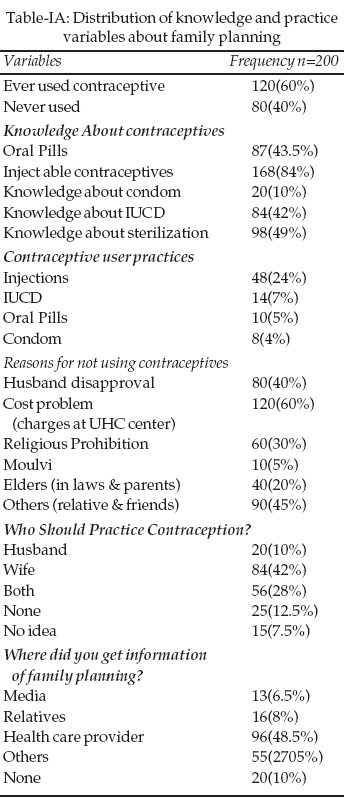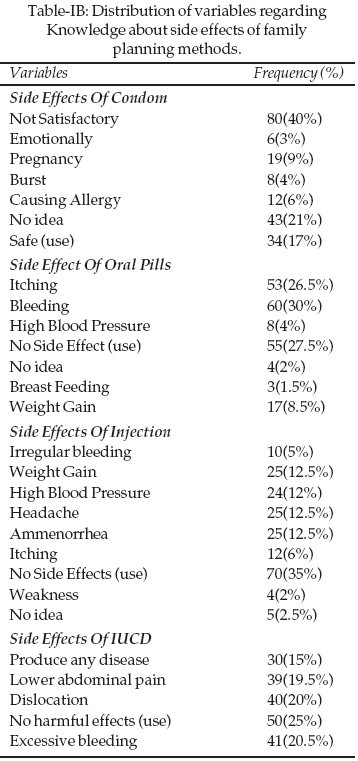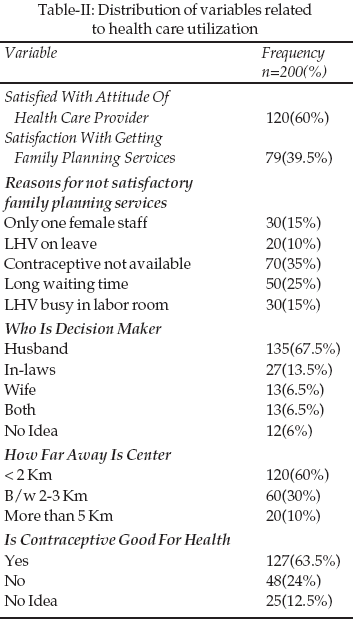|
|
||||
|
Published by : PROFESSIONAL MEDICAL PUBLICATIONS |
||||
|
ISSN 1681-715X |
||||
|
||||
|
- |
||||
|
ORIGINAL ARTICLE |
||||
|
- |
||||
|
Volume 24 |
July - September 2008 |
Number 4 |
||
|
|
||||
|
|
||||
|
|
||||
|
Published by : PROFESSIONAL MEDICAL PUBLICATIONS |
||||
|
ISSN 1681-715X |
||||
|
||||
|
- |
||||
|
ORIGINAL ARTICLE |
||||
|
- |
||||
|
Volume 24 |
July - September 2008 |
Number 4 |
||
|
|
||||
|
|
||||
Awareness and pattern of utilizing family planning services
among women attending Urban Health Care Center
Azizabad Sukkur
Naseem Aftab Shah1, Nighat Nisar2, Majid Hafeez Qadri3
ABSTRACT
Objectives: To assess level of awareness and pattern of utilizing family planning services among women (15-49 years) of reproductive age at Urban Health Center, Azizabad Sukkur, Sindh.
Methodology: A cross-sectional study was conducted from April to June 2005 at Urban Health Care Center Azizabad Sukkur. Two hundred women of reproductive age group were interviewed by using a pre tested semi structured questionnaire visiting the health care center during the study period. Information was obtained after taking informed consent regarding socio demographic characteristics, knowledge, attitude and pattern of utilizing family planning services. The data was entered and analyzed by using statistical package SPSS version 13.
Results: About 75% of women and 42.5% husbands were found illiterate, 85% women were housewives, 69.5% were married before18 years of age and 54% had nuclear family. Regarding desired number of children women responded one child (3%), 2-3 children (11%), 4-5 (37.5%), more than five children (36%), 5.5% said that children are God gifted and 7% did not answer. About 60% of women reported use of at least one contraceptive method and 40% had never used any contraceptive method. The women who received counseling from the health care provider were 48.5% and only 6% received information through media. Religious prohibition, shortage of female staff and cost of family planning contraceptive methods were the main reasons identified for not utilizing contraceptive methods. The unsatisfactory variables were long waiting hours at the center, non-availability of contraceptive, shortage of the female staff and cost.
Conclusion: Limited number of women was aware and practice contraception in the area and utilization of family planning services were low. The efforts should be made for providing information to couple and improving quality of family planning services in the area.
KEY WORDS: Birth spacing, Family planning, Contraceptives.
Pak J Med Sci July - September 2008 Vol. 24 No. 4 550-555
How to cite this article:
Shah NA, Nisar N, Qadri MH. Awareness and pattern of utilizing family planning services among women attending Urban Health Care Center Azizabad Sukkur. Pak J Med Sci 2008;24(4): 550-5.
1. Dr. Naseem Aftab Shah,
Senior Medical Officer,
Urban Health Care Center Azizabad, Sukkur
2. Dr. Nighat Nisar,
Associate Professor & Head,
Community Medicine Department SMC,
Dow University of Health Sciences,
3. Dr. Majid Hafeez Qadri,
Assistant Professor,
Community Medicine Department,
Baqai Medical University,
Karachi - Pakistan.
Correspondence
Dr. Nighat Nisar,
3-G, 6/3, Nazimabad No-3,
Karachi- 18,
Post Code: 74600,
Karachi - Pakistan.
E-mail: nisarnighat@hotmail.com
* Received for Publication: January 25, 2008
* Accepted: June 16, 2008
INTRODUCTION
Pakistan is the seventh most populous country of the world. The population will grow to 285 million by 2050 and Pakistan will rank the fourth largest nation of the world.
1 For a large and rapidly growing population in Pakistan an effective family planning program and services are of serious concern. The high population growth has exacerbated a number of problems in the country. Millions of rupees have been spent on family planning programs with no major achievements up till now. In Pakistan family planning services are available at over 1200 family welfare centers run by Ministry of Population Welfare, and also by Ministry of Healthís rural health centers and basic health units but the facilities are severely underutilized and on an average a family center receive only two clients per day.2 One of the reasons is limited mobility of women. Therefore accessing a health or family planning center in a nearby village or town is difficult and typically the husband, mother-in-law, or another adult family member is required to accompany the women. Previous researches showed that if quality of family planning services improved, the utilization of services increased and the image of the services and the provider enhanced.3,4 International planned Parenthood Federation (IPPF) defines right to information, access, choice, safety, privacy, confidentiality, dignity, comfort, continuity and opinion as fundamental right of every individuals receiving family planning services.5 We have to accelerate our efforts to improve family planning services and do more research on this topic. The key to success is to expand information and service utilization and to work more on the reasons identified for underutilization of family planning services. Researchers have neglected to investigate the health and services issues of population especially in smaller cities of developing countries including Pakistan. This study was undertaken to assess level of awareness and pattern of utilizing family planning services at Urban Health Center Sukkur, so that future planning can be built on the study results to promote and improve family planning initiative and service utilization in the particular setting.METHODOLOGY
A cross sectional study was conducted at urban health center Azizabad at Sukkur. The data was collected in three months from April to June 2005. A pre tested semi structured questionnaire was used to interview 200 women coming consecutively for receiving family planning services during the study period at the center. Information obtained after informed consent regarding socio demographic characteristics like age, income, religion, age at marriage, actual number of children, desired number of children, educational status of women and husband, knowledge, attitude and pattern of utilizing family planning services. Married women of reproductive age group (15-49 years) and resident of Azizabad, Sukkur, were included in the study. The data collected was entered and analyzed by using statistical package SPSS version 13.
RESULTS
In all two hundred respondents were interviewed. The socio-demographic characteristics of the study population showed that 22.5% of women belong to age group 18-27 years, 47.5% were 28 Ė 35 years and 30% were above 35 years of age. About 7.5% women were employed, 85% were housewife and 7.5% were beggars. Regarding husband occupation 45% were labourer 27.5% were in government job, 10% were businessman and 10% were un-employed while 7.5% were beggars. About 42.5% husbands were illiterate, 22.5% had primary education, 16.5% had secondary, 12% intermediate, 2% graduate and 4.5% had postgraduate education. About 75% women were illiterate, 9% had primary education, and 6.5% secondary, 7.5% intermediate and 2% had graduation. About 69.5% of the respondents were married before18 years of age while 26.5% were married at the age of 19-29 years and 4% were married above 30 years of age. About 54% live in nuclear family, 38% joint family and 8% in extended joint family system. Regarding desired number of children women responded one child (3%), 2-3 children (11%), 4-5 (37.5%), more than five children (36%), 5.5% said that children are God gifted and 7% did not answer.
Table-IA, describes the distribution of knowledge variables. About 60% of women reported use of at least one contraceptive method in their lifetime while 40% had never used contraceptives. About 43.5% knew about oral pills and out of these only 5% were users, 84% knew about injectable contraceptive and 24% practiced it because they can easily hide from husbands/in-laws. Only (10%) knew about condom and 4% were users, 42% knew about intra uterine contraceptive device and 7% had used this, and 49% knew about sterilization and no one had gone through this procedure. About 40% had never used any contraceptive methods because of husband disapproval. Regarding cost of contraceptive, 60% of women reported that they are paying out of their pockets at the center and 40% were getting free of cost from Lady Health Workers so they preferred to wait for them to come to their home. About 30% believe that contraceptives are prohibited in religion, 20% had learnt from elders, 45% through others and 5% received information from religious leaders (moulvi sahib) about prohibition of contraceptive in religion. Regarding practicing contraception, 42% reported wife, 28% both, 12.5% no one, 10% husband while 7.5% said they have no idea who should practice contraception. About getting information, only 48% received information regarding family planning through heath care provider, 6% through media, 8% relative and 27% from other sources and 10% were not informed through any source.

Table-IB, describes the variables about side effect of Family Planning contraceptives. About side effects of condom, 40% reported husband dissatisfaction, 17% consider it safe, 9% fear of becoming pregnant, 6% allergy, and 4% consider it unsafe (burst) and 21% had no idea about its use. The side effects of oral pills reported were (4%) high blood pressure, itching, (26.5%) weight gain, (8.5%) bleeding, (30%) and reported no side effect and 2% did not know. Regarding side effects of injectable 35% reported no side effects, 12.5% amenorrhea, 12.5% weight gain, 12.5% headache, 5% irregular bleeding, 6% itching, 2.5% do not know and 2% weakness. The side effects of intra uterine device reported were excessive bleeding (20.5%) dislocation (20%) and lower abdominal pain (19.5%) complained of dislocation, 15% said it can produce diseases, and 25% of reported no harmful effect.

Table-II describes the health care utilization, 60% of women reported that they are satisfied with attitude of the health care staff and 39.5% said that were satisfied with receiving family planning services provided to them. About 35% of women reported non-availability of contraceptives, 25% complained of long waiting time, 15% reported availability of only one female staff and when they come for family planning services they found her busy in labor room and when she was on leave no substitute of her was available. Majority of decisions were from husbands (67.5%), in-laws, (13.5%) both, (6.5%) sixty five had no idea and only 6.5% of women reported that they were involved in decision-making. About 60% of women reported that they have to travel less than two km, 30% two to three km and 10% have to travel more than five km to reach the facility. About 63.5% women perceived that contraceptives are good for health and 24% said that these are not good for health and 12.55% had no idea about it.

DISCUSSION
Population explosion is the burning issue. Only contraceptive is the method to check this exponential population growth. Family Planning has been considered as an effective way to improve health of the mother and child and enables to decide freely and responsibly the number and spacing of their children. According to Pakistan fertility and family planning survey, the Contraception Prevalence Rate (CPR) in the country is only 24% in spite of the fact that 94 per cent have heard of at-least one method of Family Planning.
7 The findings of our study showed that sixty percent of women had never used family planning methods but discontinued it due to fear of side effects and a number of women also reported experiences of having side effects and rest of the forty percent had never used contraceptive. About 40% stated husband disapproval.Man approval and decision making is very important in utilizing family planning services. Our study showed that majority of decision makers was husband regarding number of children and contraceptive practice. Similar findings have been reported from a study conducted in Bangladesh that about 85% women require husband approval for practicing contraception.
8 A cross sectional study in GAZA reported fear of side effects in 68% of women and husbands opposition 31% were the main factor for not using family planning method.9 Another study conducted in Turkey reported husbandís disapproval was the main factor for not using any Family Planning (FP) methods among married women.9 On the contrary a recent study at tertiary care hospital at Lahore found that nearly 74% of men had positive attitude towards contraception.10 Education plays an important role in womenís life and assist in decision-making.11 Pakistan has very low literacy rate which is more in rural areas.12 Our study showed that 75% of women were illiterate in spite of the fact they were living in urban areas of Sukkur. A study carried out in Tanzania showed that women education and number of children were the main factors associated with family planning use.13 In Pakistan fertility decline and use of contraceptive have shown a great resistance, more than fifty percent of the population still desire for more children with son preferences. Our study findings showed that two third of women desire for four and more than five children. About half of the study sample knew about oral pill and sterilization but only few use them while none had gone through sterilization. A cross sectional study conducted in district Khairpur showed that the oral pills was the pre-dominant method and 90% of respondent knew about oral pills followed by 88.3% female sterilization and inject able contraceptive 87.6%.14 Media is considered to play an important role in providing information to masses, in our study only six percent of women got family planning information from the media and health care providers remains the predominant source of information which is encouraging but media has to prove its role in combating resistance to fertility decline in Pakistan.Utilization of services is a great challenge in improving family planning services in our country. Over half (53%) of the currently married users of contraception obtain their supplies from public sector hospitals and 45% get from private sector. The quality of services from public sector needs improvement as our study results also identified some areas such as long waiting time, availability of supplies, cost, and lack of female staff. The overall status of women should be improved by improving services and increasing maternal and child health awareness in this particular community. Efforts should be made to increase awareness of modern contraception, decrease waiting time and cost should be reduced and more female health care staff should be posted a the center. Media should play more emphasis on contraceptive promotion.
CONCLUSION
The study concluded that limited number of women was aware and practice contraception in the area and utilization of family planning services were low. The efforts should be made for providing information to couple and improving quality of family planning services in the area.
REFERENCES
1. World Population Prospects: The 1998 Revision. New York, NY: Population Division, United Nations; 1999.
2. Cernada GP, Rob AKU, Ameen SI, Ahmad MS. A Situation Analysis of Family Welfare Centers in Pakistan. Islamabad, Pakistan: Population Council; 1993.
3. Diaz J, Diaz M. Quality of care in family planning in Latin America. Adv Contracept 1993;9(2):117-28.
4. Inaoka E, Wakais, Nakamura Y, AL Babily Y, Saghayroun AA, Correlates of visit regularity among family Planning clients in Urban Yemen. Adv Contracept 1999;15(4):257-74.
5. Williams T, Schutt-Aine J. Measuring Family Planning services through Client Satisfaction Exit Interviews. International Family Planning Perspective 2000;2(2):63-71.
6. Pakistan fertility and family planning survey Islamabad National Institute of Population Studies, 1998.
7. Islam MA, Padmadass S, Smith PW. Menís approval of family planning in Bangladesh. J Biosoc Sci 2006;38:247-59.
8. Donati S, Hamam R, Medda E. Family planning KAP survey in Gaza. Soc Sci Med 2000;50:841-9.
9. Shahin HA, Shahin HG. Reasons for not using family planning methods in Eastern Turkey. Eur J Contracept Reprod Health Care 2003;8:11-6.
10. Khawaja NP, Tayyeb R, Malik N. Awareness and practices of contraception among Pakistani women attending a tertiary care hospital. J Obstet Gynaecol 2004;24:564-7.
11. Gage AJ. Women socioeconomic position and contraceptive behavior in Togo. Stud Fam Plann 1995;26:264-77.
12. Economic survey of Pakistan. Islamabad: Ministry of Finance, Government of Pakistan, 2000.
13. Marchant T, Mushi AK, Nathan R, Mukasa O, Abdullah S, Lengelen C, et al. Planning a family: priorities and concerns in rural Tanzania. Afr J Reprod Health 2004;8:111-23.
14. Ali S, White FM. Family planning practices among currently married women in Khairpur District, Sindh, Pakistan. J Coll Physician Surg Pak 2005;15:422-5.
HOME | SEARCH | CURRENT ISSUE | PAST ISSUES
Professional
Medical Publications
Room No. 522, 5th Floor, Panorama Centre
Building No. 2, P.O. Box 8766, Saddar, Karachi - Pakistan.
Phones : 5688791, 5689285 Fax : 5689860
pjms@pjms.com.pk